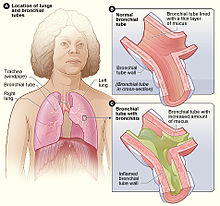
Back Brongitis Afrikaans Bronquitis AN التهاب القصبات Arabic Bronquitis AST Bronxit Azerbaijani برونخیت AZB Бранхіт Byelorussian Бронхит Bulgarian ব্রংকাইটিস Bengali/Bangla Bronhitis BS
| Bronchitis | |
|---|---|
 | |
| Figure A shows the location of the lungs and bronchial tubes. Figure B is an enlarged view of a normal bronchial tube. Figure C is an enlarged view of a bronchial tube with bronchitis. | |
| Pronunciation | |
| Specialty | Infectious disease, pulmonology |
| Symptoms | Coughing up mucus, wheezing, shortness of breath, chest discomfort[1] |
| Types | Acute, chronic[1] |
| Frequency | Acute: ~5% of people a year[2][3] Chronic: ~5% of people[3] |
Bronchitis is inflammation of the bronchi (large and medium-sized airways) in the lungs that causes coughing. Bronchitis usually begins as an infection in the nose, ears, throat, or sinuses. The infection then makes its way down to the bronchi. Symptoms include coughing up sputum, wheezing, shortness of breath, and chest pain. Bronchitis can be acute or chronic.[1]
Acute bronchitis usually has a cough that lasts around three weeks,[4] and is also known as a chest cold.[5] In more than 90% of cases, the cause is a viral infection.[4] These viruses may be spread through the air when people cough or by direct contact.[6] A small number of cases are caused by a bacterial infection such as Mycoplasma pneumoniae or Bordetella pertussis.[4] Risk factors include exposure to tobacco smoke, dust, and other air pollution.[6] Treatment of acute bronchitis typically involves rest, paracetamol (acetaminophen), and nonsteroidal anti-inflammatory drugs (NSAIDs) to help with the fever.[7][8]
Chronic bronchitis is defined as a productive cough – one that produces sputum – that lasts for three months or more per year for at least two years.[9][10] Many people with chronic bronchitis also have chronic obstructive pulmonary disease (COPD).[11] Tobacco smoking is the most common cause, with a number of other factors such as air pollution and genetics playing a smaller role.[12] Treatments include quitting smoking, vaccinations, rehabilitation, and often inhaled bronchodilators and steroids.[13] Some people may benefit from long-term oxygen therapy.[13]
Acute bronchitis is one of the more common diseases.[7][14] About 5% of adults and 6% of children have at least one episode a year.[2][15] Acute bronchitis is the most common type of bronchitis.[16] By contrast in the United States, in 2018, 9.3 million people were diagnosed with the less common chronic bronchitis.[17][18]
- ^ a b c "Bronchitis". NHLBI. Retrieved 9 June 2019.
- ^ a b Wenzel, RP; Fowler AA, 3rd (16 November 2006). "Clinical practice. Acute bronchitis". The New England Journal of Medicine. 355 (20): 2125–30. doi:10.1056/nejmcp061493. PMID 17108344.
{{cite journal}}: CS1 maint: numeric names: authors list (link) - ^ a b Vos T, Flaxman AD, Naghavi M, Lozano R, Michaud C, Ezzati M, Shibuya K, Salomon JA, Abdalla S, Aboyans V, et al. (December 2012). "Years lived with disability (YLDs) for 1160 sequelae of 289 diseases and injuries 1990–2010: a systematic analysis for the Global Burden of Disease Study 2010". Lancet. 380 (9859): 2163–96. doi:10.1016/S0140-6736(12)61729-2. PMC 6350784. PMID 23245607.
- ^ a b c Kin, S (1 October 2016). "Acute Bronchitis". American Family Physician. 94 (7): 560–565. PMID 27929206.
- ^ "Antibiotics Aren't Always the Answer". Centers for Disease Control and Prevention. 25 September 2017.
- ^ a b "What Is Bronchitis?". August 4, 2011. Archived from the original on 2 April 2015. Retrieved 1 April 2015.
- ^ a b Tackett, KL; Atkins, A (December 2012). "Evidence-based acute bronchitis therapy". Journal of Pharmacy Practice. 25 (6): 586–90. doi:10.1177/0897190012460826. PMID 23076965. S2CID 37651935.
- ^ "How Is Bronchitis Treated?". August 4, 2011. Archived from the original on 2 April 2015. Retrieved 1 April 2015.
- ^ "Bronchitis, Chronic". Medical Subject Headings. National Library of Medicine. MeSH D029481. Retrieved 2023-03-16.
- ^ Cite error: The named reference
GOLD2019was invoked but never defined (see the help page). - ^ Reilly, John J.; Silverman, Edwin K.; Shapiro, Steven D. (2011). "Chronic Obstructive Pulmonary Disease". In Longo, Dan; Fauci, Anthony; Kasper, Dennis; Hauser, Stephen; Jameson, J.; Loscalzo, Joseph (eds.). Harrison's Principles of Internal Medicine (18th ed.). McGraw Hill. pp. 2151–9. ISBN 978-0-07-174889-6.
- ^ Decramer M, Janssens W, Miravitlles M (April 2012). "Chronic obstructive pulmonary disease". Lancet. 379 (9823): 1341–51. CiteSeerX 10.1.1.1000.1967. doi:10.1016/S0140-6736(11)60968-9. PMC 7172377. PMID 22314182.
- ^ a b Rabe KF, Hurd S, Anzueto A, Barnes PJ, Buist SA, Calverley P, Fukuchi Y, Jenkins C, Rodriguez-Roisin R, van Weel C, Zielinski J (September 2007). "Global strategy for the diagnosis, management, and prevention of chronic obstructive pulmonary disease: GOLD executive summary". Am. J. Respir. Crit. Care Med. 176 (6): 532–55. doi:10.1164/rccm.200703-456SO. hdl:2066/51740. PMID 17507545. S2CID 20863981.
- ^ Braman, SS (January 2006). "Chronic cough due to acute bronchitis: ACCP evidence-based clinical practice guidelines". Chest. 129 (1 Suppl): 95S – 103S. doi:10.1378/chest.129.1_suppl.95S. PMC 7094612. PMID 16428698.
- ^ Fleming, DM; Elliot, AJ (March 2007). "The management of acute bronchitis in children". Expert Opinion on Pharmacotherapy. 8 (4): 415–26. doi:10.1517/14656566.8.4.415. PMID 17309336. S2CID 46247982.
- ^ "Bronchitis". WebMD. Retrieved 13 January 2024.
- ^ "FastStats". Centers for Disease Control and Prevention. 23 May 2019. Retrieved 30 May 2019.
- ^ Villarroel, MA; Blackwell, DL; Jen, A (2019), "Summary Health Statistics: National Health Interview Survey, 2018" (PDF), ftp.cdc.gov, retrieved 22 March 2020